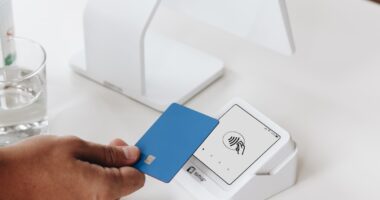Non-fungible tokens (NFTs) have been making headlines in the art world and beyond, but what exactly are they and how do they work? NFTs are unique digital assets that are stored on a blockchain, which is a decentralized and secure digital ledger. Unlike cryptocurrencies such as Bitcoin or Ethereum, which are fungible and can be exchanged on a one-to-one basis, NFTs are non-fungible, meaning each one is unique and cannot be exchanged on a like-for-like basis. This uniqueness is what gives NFTs their value and appeal to collectors and creators alike.
NFTs can represent a wide range of digital assets, including artwork, music, videos, and even virtual real estate. When an artist creates an NFT, they are essentially creating a digital certificate of ownership for their work, which is then stored on the blockchain. This certificate includes information about the asset, such as its creator, its current owner, and its provenance. Because this information is stored on a blockchain, it is secure and cannot be altered or tampered with, providing a level of authenticity and trust that is often lacking in the digital art world. When an NFT is bought or sold, the transaction is recorded on the blockchain, allowing for transparent and verifiable ownership transfers.
In recent years, NFTs have gained popularity as a way for artists to monetize their digital creations and for collectors to invest in unique and rare digital assets. The appeal of NFTs lies in their ability to provide proof of ownership and scarcity in the digital realm, which has historically been difficult to achieve. As the technology continues to evolve and gain mainstream acceptance, NFTs have the potential to revolutionize the way we buy, sell, and collect digital art and other digital assets.
NFT Artists: How to Create and Sell Digital Art on the Blockchain
For artists looking to enter the world of NFTs, there are several steps to consider when creating and selling digital art on the blockchain. The first step is to create a digital artwork that you want to turn into an NFT. This can be anything from a digital painting or illustration to a 3D model or animation. Once you have your artwork ready, you will need to choose a platform to mint your NFT. There are several NFT marketplaces and platforms that allow artists to mint and sell their NFTs, each with its own set of features and fees.
After choosing a platform, you will need to create an account and connect a digital wallet to store your cryptocurrency earnings from NFT sales. Once your wallet is set up, you can then upload your artwork and mint it as an NFT. Minting an NFT involves creating a unique token on the blockchain that represents your artwork and includes information about its creator, ownership, and provenance. Once your NFT is minted, it will be listed for sale on the platform, where collectors can bid on or purchase it using cryptocurrency.
Selling NFTs can be a lucrative opportunity for artists, as they can earn royalties each time their NFT is resold on the secondary market. Additionally, NFTs provide a way for artists to connect directly with collectors and fans, bypassing traditional art galleries and middlemen. As the NFT market continues to grow, more opportunities are emerging for artists to showcase and sell their digital creations on the blockchain.
NFT Jobs: Opportunities in the Growing NFT Industry
The growing popularity of NFTs has created new job opportunities in the blockchain and digital art industries. As more artists and collectors enter the NFT market, there is a growing demand for professionals with expertise in blockchain technology, digital marketing, and art curation. One of the most in-demand roles in the NFT industry is that of an NFT curator, who is responsible for selecting and showcasing digital artworks on NFT platforms. Curators play a crucial role in promoting artists and helping collectors discover new and exciting NFT artworks.
Another emerging role in the NFT industry is that of an NFT marketer, who specializes in promoting and selling NFT artworks to collectors and investors. NFT marketers use their knowledge of digital marketing strategies and social media to create buzz around new NFT releases and attract potential buyers. Additionally, there is a growing need for blockchain developers who can create and maintain the infrastructure that supports NFT marketplaces and platforms. These developers are responsible for ensuring the security and functionality of the blockchain technology that underpins NFTs.
As the NFT industry continues to evolve, there will likely be even more job opportunities for professionals with skills in areas such as art curation, marketing, blockchain development, and legal expertise. The rise of NFTs has created a new ecosystem of opportunities for individuals looking to work at the intersection of art, technology, and finance.
NFT News: The Latest Trends and Developments in the NFT Market
| Date | Number of NFTs Sold | Top Selling NFT |
|---|---|---|
| January 2022 | 500,000 | CryptoPunk #7804 |
| February 2022 | 700,000 | Art Blocks Fidenza #313 |
| March 2022 | 900,000 | Board Ape Yacht Club #3656 |
The NFT market is constantly evolving, with new trends and developments emerging on a regular basis. One of the latest trends in the NFT market is the rise of virtual real estate as a popular form of digital asset. Virtual real estate NFTs represent ownership of virtual land or property within online worlds such as Decentraland or The Sandbox. These virtual real estate NFTs have become highly sought after by collectors and investors looking to capitalize on the growing popularity of virtual worlds.
Another trend in the NFT market is the increasing use of blockchain technology to verify the authenticity of physical artworks. Some artists and art galleries are using NFTs as a way to create digital certificates of authenticity for physical artworks, providing buyers with a secure way to verify the provenance of their purchases. This use of NFTs in the traditional art world has the potential to revolutionize how physical artworks are bought, sold, and authenticated.
In addition to these trends, there have been several high-profile sales of NFT artworks by well-known artists, further cementing the legitimacy and value of NFTs in the art world. These sales have garnered attention from mainstream media outlets and have helped to bring NFTs into the public eye. As the NFT market continues to grow and evolve, it will be important for collectors, artists, and investors to stay informed about the latest trends and developments in order to make informed decisions about buying, selling, and creating NFTs.
Minting an NFT: Step-by-Step Guide to Creating and Selling Your Own NFT
Minting an NFT involves several steps that artists can follow to create and sell their own digital artwork on the blockchain. The first step is to choose a platform or marketplace where you want to mint your NFT. There are several popular platforms such as OpenSea, Rarible, and Foundation that allow artists to mint and sell their NFTs. Each platform has its own set of features, fees, and requirements for minting an NFT.
Once you have chosen a platform, you will need to create an account and connect a digital wallet to store your cryptocurrency earnings from NFT sales. After setting up your wallet, you can then upload your artwork and mint it as an NFT. This process typically involves providing information about your artwork, such as its title, description, and file format. You will also need to set a price for your NFT or choose to list it for auction.
After minting your NFT, it will be listed for sale on the platform where collectors can bid on or purchase it using cryptocurrency. Once your NFT is sold, you will receive payment in cryptocurrency directly to your digital wallet. Additionally, many platforms offer features that allow artists to earn royalties each time their NFT is resold on the secondary market. Minting an NFT provides artists with a unique opportunity to showcase and sell their digital creations while connecting directly with collectors and fans.
NFT Platforms: Where to Showcase and Sell Your NFT Artwork

There are several popular platforms where artists can showcase and sell their NFT artwork to collectors and investors. OpenSea is one of the largest and most well-known NFT marketplaces, offering a wide range of digital assets including artwork, music, domain names, virtual real estate, and more. OpenSea allows artists to mint their own NFTs without any upfront costs or approval process, making it accessible to creators of all levels.
Rarible is another popular platform that allows artists to create and sell their own NFTs without any coding knowledge required. Rarible uses its own token (RARI) as part of its governance model, allowing creators to earn RARI tokens by participating in platform governance decisions. Foundation is a curated platform that focuses on showcasing high-quality digital artwork from emerging artists. Artists must apply to join Foundation’s community before they can mint their own NFTs.
In addition to these platforms, there are several others such as SuperRare, KnownOrigin, and Mintable that cater to different types of digital artwork and offer various features for creators and collectors. Each platform has its own set of fees, features, and community guidelines that artists should consider when choosing where to showcase and sell their NFT artwork.
NFT Collectors: How to Buy and Invest in NFT Artworks on the Blockchain
For collectors looking to buy and invest in NFT artworks on the blockchain, there are several steps to consider when navigating the world of digital art collecting. The first step is to choose a platform or marketplace where you want to browse and purchase NFT artworks. There are several popular platforms such as OpenSea, Rarible, SuperRare, KnownOrigin, Foundation, and more that offer a wide range of digital assets for collectors to explore.
Once you have chosen a platform, you can browse through various categories of digital artwork such as illustrations, animations, virtual real estate, music, videos, and more. Each artwork will have its own unique characteristics such as rarity, edition size, creator information, provenance details, and price. Collectors can use cryptocurrency to bid on or purchase their desired artworks directly from the platform.
When buying an NFT artwork, it’s important for collectors to consider factors such as the artist’s reputation, the rarity of the artwork, its potential for appreciation in value over time, and its overall aesthetic appeal. Additionally, collectors should be aware of any resale royalties that may be associated with the artwork if they plan to sell it in the future. Buying and investing in NFT artworks provides collectors with a unique opportunity to own rare digital assets while supporting artists directly on the blockchain.
If you’re interested in learning more about minting an NFT, you should check out this article on NFT-Jobs.com. The article provides a comprehensive guide on how to mint your own NFT and get started in the world of digital art and collectibles. Whether you’re an artist looking to showcase your work or a collector interested in investing in NFTs, this article offers valuable insights and tips for navigating the NFT marketplace. (source)
FAQs
What is minting an NFT?
Minting an NFT refers to the process of creating a unique digital asset on a blockchain. This process involves turning a digital file, such as an image, video, or audio clip, into a non-fungible token (NFT) by uploading it to a platform that supports NFT creation.
How does minting an NFT work?
Minting an NFT typically involves using a specialized platform or marketplace that supports NFT creation. Users upload their digital files, provide metadata and details about the asset, and then pay a fee to have the NFT created and added to the blockchain.
What is the purpose of minting an NFT?
Minting an NFT allows creators to tokenize their digital assets, providing proof of ownership and uniqueness. This can enable artists, musicians, and other creators to sell and monetize their digital work in a secure and transparent manner.
What can be minted as an NFT?
Almost any digital file can be minted as an NFT, including images, videos, music, digital art, virtual real estate, and even tweets or memes. The key requirement is that the digital file must be unique and owned by the creator.
Is minting an NFT environmentally friendly?
The process of minting an NFT involves the use of blockchain technology, which has raised concerns about its environmental impact due to the energy consumption of some blockchain networks. However, there are efforts to develop more sustainable solutions for NFT minting.





